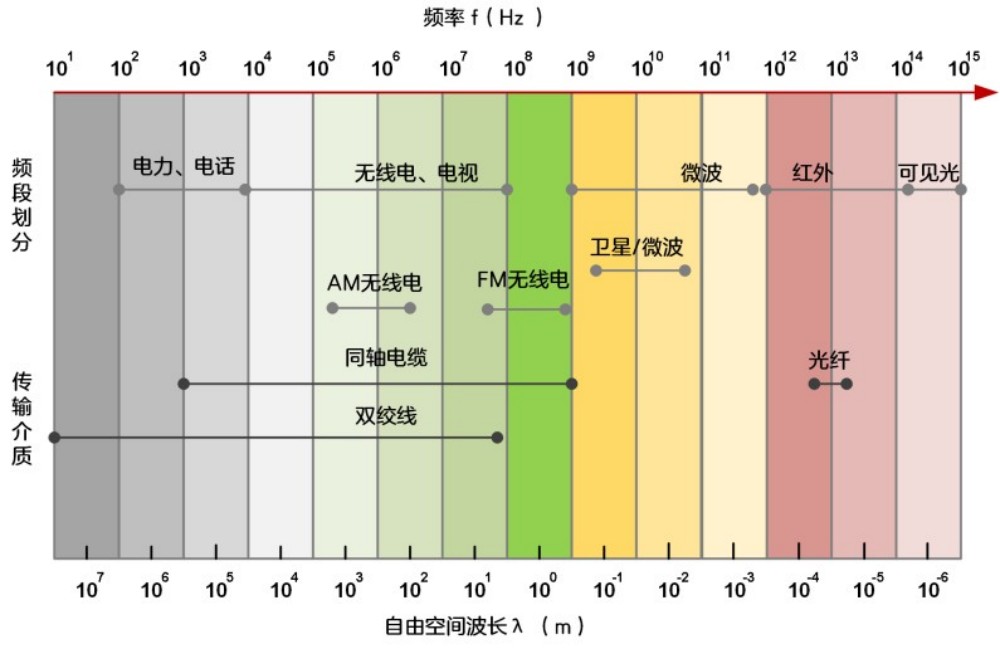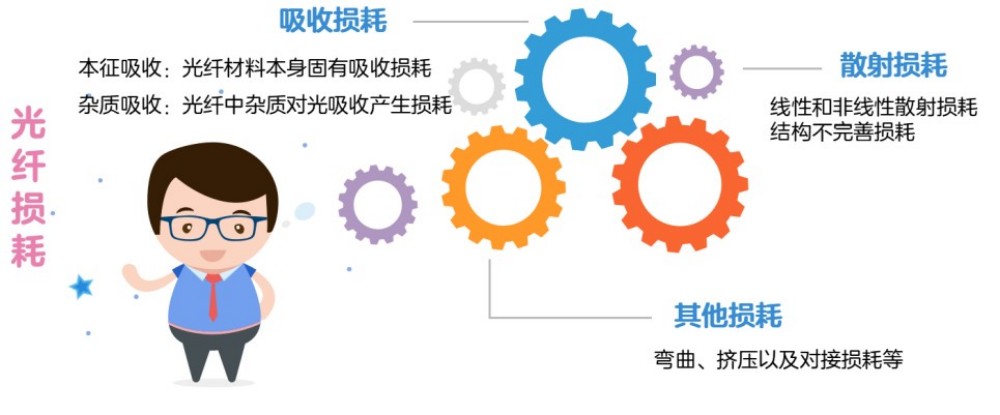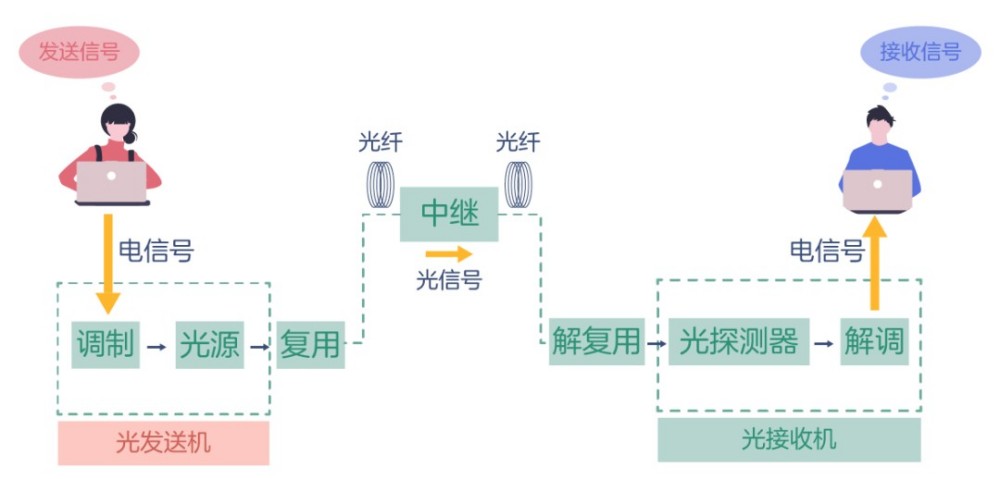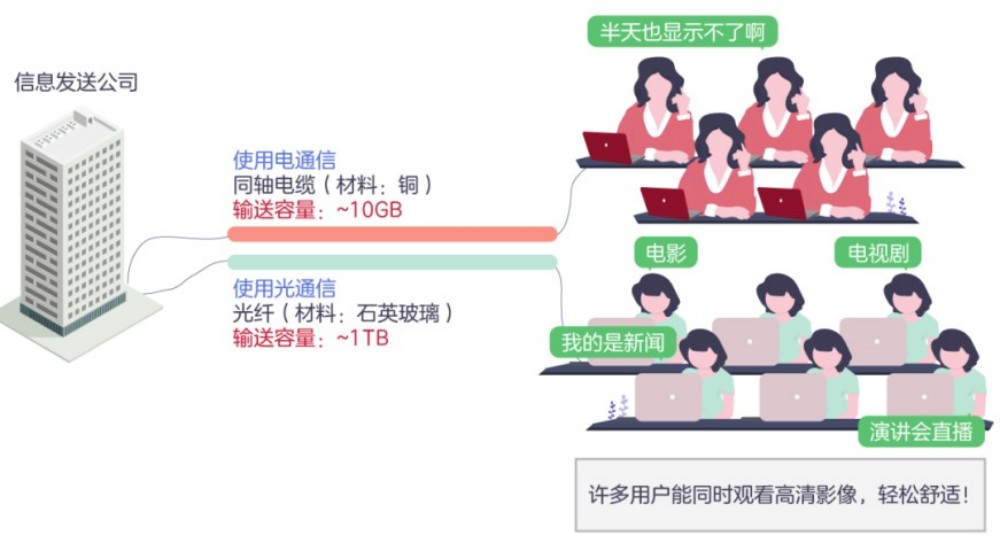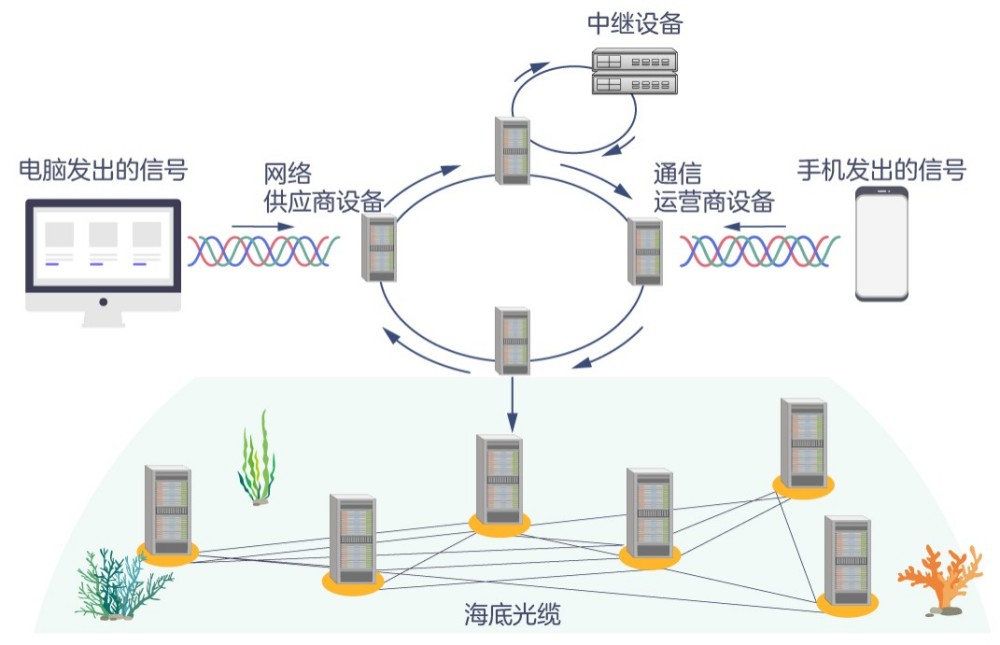The invention of optical fiber has driven the revolution in the field of communication. If there is no optical fiber to provide high-capacity high-speed channels, the Internet can only stay in the theoretical stage. If the 20th century was the era of electricity, then the 21st century is the era of light. How does light achieve communication? Let’s learn the basic knowledge of optical communication together with the editor below.
Part 1. Basic knowledge of light propagation
Understanding light waves
Light waves are actually electromagnetic waves, and in free space, the wavelength and frequency of electromagnetic waves are inversely proportional. The product of the two is equal to the speed of light, that is:
Arrange the wavelengths or frequencies of electromagnetic waves in order to form an electromagnetic spectrum. According to the different wavelengths or frequencies, electromagnetic waves can be divided into radiation region, ultraviolet region, visible light region, infrared region, microwave region, radio wave region, and long wave region. The bands used for communication are mainly the infrared region, microwave region, and radio wave region. The following image will help you understand the division of communication bands and corresponding propagation media in minutes.
The protagonist of this article, “Fiber Optic Communication,” uses light waves in the infrared band. When it comes to this point, people may wonder why it must be in the infrared band? This issue is related to the optical transmission loss of optical fiber materials, namely silica glass. Next, we need to understand how optical fibers transmit light.
Refraction, reflection, and total reflection of light
When light is emitted from one substance to another, refraction and reflection occur at the interface between the two substances, and the angle of refraction increases with the angle of the incident light. As shown in Figure ①→②. When the incident angle reaches or exceeds a certain angle, the refracted light disappears and all the incident light is reflected back, which is the total reflection of light, as shown in ② → ③ in the following figure.
Different materials have different refractive indices, so the speed of light propagation varies in different media. The refractive index is represented by n, n=c/v, where c is the velocity in vacuum and v is the propagation velocity in the medium. A medium with a higher refractive index is called an optically dense medium, while a medium with a lower refractive index is called an optically sparse medium. The two conditions for total reflection to occur are:
1. Transmission from optically dense medium to optically sparse medium
2. The incident angle is greater than or equal to the critical angle of total reflection
In order to avoid optical signal leakage and reduce transmission loss, optical transmission in optical fibers occurs under total reflection conditions.
Part 2. Introduction to Optical Propagation Media (Fiber Optic)
With the basic knowledge of total reflection light propagation, it is easy to understand the design structure of optical fibers. The bare fiber of optical fiber is divided into three layers: the first layer is the core, which is located at the center of the fiber and is composed of high-purity silicon dioxide, also known as glass. The core diameter is generally 9-10 microns (single-mode), 50 or 62.5 microns (multi-mode). The fiber core has a high refractive index and is used to transmit light. Second layer cladding: located around the fiber core, also composed of silica glass (with a diameter of generally 125 microns). The refractive index of the cladding is low, forming a total reflection condition together with the fiber core. The third coating layer: The outermost layer is a reinforced resin coating. The protective layer material has high strength and can withstand large impacts, protecting the optical fiber from water vapor erosion and mechanical abrasion.
Fiber optic transmission loss is a very important factor affecting the quality of fiber optic communication. The main factors causing attenuation of optical signals include absorption loss of materials, scattering loss during transmission, and other losses caused by factors such as fiber bending, compression, and docking loss.
The wavelength of light is different, and the transmission loss in optical fibers is also different. In order to minimize the loss and ensure the transmission effect, scientists have been committed to finding the most suitable light. The light in the wavelength range of 1260nm~1360nm has the smallest signal distortion caused by dispersion and the lowest absorption loss. In the early days, this wavelength range was adopted as the optical communication band. Later, after a long period of exploration and practice, experts gradually summarized a low loss wavelength range (1260nm~1625nm), which is most suitable for transmission in optical fibers. So the light waves used in fiber optic communication are generally in the infrared band.
Multimode optical fiber: transmits multiple modes, but the large inter modal dispersion limits the frequency of transmitting digital signals, and this limitation becomes more severe with increasing transmission distance. Therefore, the distance of multimode fiber optic transmission is relatively short, usually only a few kilometers.
Single mode fiber: With a very small fiber diameter, theoretically only one mode can be transmitted, making it suitable for remote communication.
| Comparison item | Multimode fiber | Single mode fiber |
| Fiber optic cost | high cost | low cost |
| Transmission equipment requirements | low equipment requirements, low equipment costs | high equipment requirements, high light source requirements |
| Attenuation | high | low |
| Transmission wavelength: 850nm-1300nm | 1260nm-1640nm | |
| Convenient to use | larger core diameter, easy to handle | more complex connection for use |
| Transmission distance | local network | |
| (less than 2km) | access network | medium to long distance network |
| (Greater than 200km) | ||
| Bandwidth | Limited bandwidth | Almost unlimited bandwidth |
| Conclusion | Fiber optic is more expensive, but the relative cost of network activation is lower | Higher performance, but higher cost of establishing a network |
Part 3. Working principle of fiber optic communication system
Optical fiber communication system
The communication products commonly used, such as mobile phones and computers, transmit information in the form of electrical signals. When conducting optical communication, the first step is to convert electrical signals into optical signals, transmit them through fiber optic cables, and then convert the optical signals into electrical signals to achieve the purpose of information transmission. The basic optical communication system consists of an optical transmitter, an optical receiver, and a fiber optic circuit for transmitting light. In order to ensure the quality of long-distance signal transmission and improve transmission bandwidth, optical repeaters and multiplexers are generally used.
Below is a brief introduction to the working principle of each component in the fiber optic communication system.
Optical transmitter: converts electrical signals into optical signals, mainly composed of signal modulators and light sources.
Signal multiplexer: couples multiple optical carrier signals of different wavelengths into the same optical fiber for transmission, achieving the effect of doubling transmission capacity.
Optical repeater: During transmission, the waveform and intensity of the signal will deteriorate, so it is necessary to restore the waveform to the original signal’s neat waveform and increase the light intensity.
Signal demultiplexer: Decompose the multiplexed signal into its original individual signals.
Optical receiver: converts the received optical signal into an electrical signal, mainly composed of a photodetector and a demodulator.
Part 4. Advantages and Applications of Optical Communication
Advantages of Optical Communication:
1. Long relay distance, economical and energy-saving
Assuming the transmission of 10 Gbps (10 billion 0 or 1 signals per second) of information, if electrical communication is used, the signal needs to be relayed and adjusted every few hundred meters. Compared to this, using optical communication can achieve a relay distance of over 100 kilometers. The fewer times the signal is adjusted, the lower the cost. On the other hand, the material of optical fiber is silicon dioxide, which has abundant reserves and much lower cost than copper wire. Therefore, optical communication has an economic and energy-saving effect.
2. Fast information transmission and high communication quality
For example, now when talking to friends abroad or chatting online, the sound is not as lagging as before. In the era of telecommunication, international communication mainly relies on artificial satellites as relays for transmission, resulting in longer transmission paths and slower signal arrival. And optical communication, with the help of submarine cables, shortens the transmission distance, making information transmission faster. Therefore, using optical communication can achieve smoother communication with overseas.
3. Strong anti-interference ability and good confidentiality
Electrical communication may experience errors due to electromagnetic interference, leading to a decrease in communication quality. However, optical communication is not affected by electrical noise, making it safer and more reliable. And due to the principle of total reflection, the signal is completely confined to the optical fiber for transmission, so the confidentiality is good.
4. Large transmission capacity
Generally, electrical communication can only transmit 10Gbps (10 billion 0 or 1 signals per second) of information, while optical communication can transmit 1Tbps (1 trillion 0 or 1 signals) of information.
Application of Optical Communication
There are many advantages to optical communication, and it has been integrated into every corner of our lives since its development. Devices such as mobile phones, computers, and IP phones that use the internet connect everyone to their region, the entire country, and even to the global communication network. For example, signals emitted by computers and mobile phones gather at local communication operator base stations and network provider equipment, and are then transmitted to various parts of the world through fiber optic cables in submarine cables.
The realization of daily activities such as video calls, online shopping, video games, and binge watching all rely on its support and assistance behind the scenes. The emergence of optical networks has made our lives more comfortable and convenient.
Post time: Mar-31-2025




